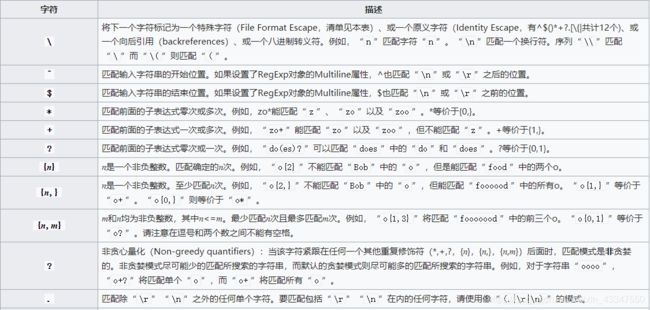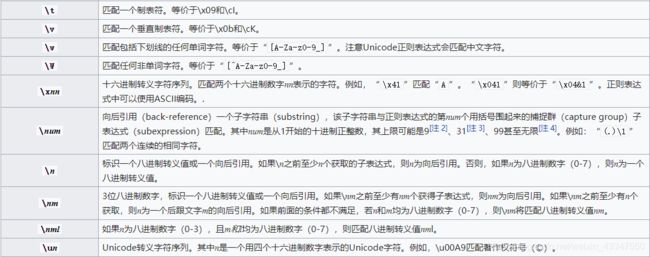Python正则表达式详解 (超详细,看完必会!)
正则表达式详解
正则表达式 英文名称叫 Regular Expression简称RegEx,是用来匹配字符的一种工具,它常被用在网页爬虫,文稿整理,数据筛选等方面,最常用的就是用在网页爬虫,数据抓取。
一、正则表达式的各种符号解释
二、进行逐个详解
1.首先导入模块
import re
2.匹配多种可能 使用 []
#'run' or 'ran'
res = re.search(r'r[au]n','dog runs to cat')
print(res)
>>> <re.Match object; span=(4, 7), match='run'>
res = re.search(r'r[au]n','dog rans to cat')
print(res)
>>> <re.Match object; span=(4, 7), match='ran'>
#continue 匹配更多种可能
res = re.search(r'r[A-Z]n','dog rans to cat')
print(res)
>>> None
res = re.search(r'r[a-z]n','dog rans to cat')
print(res)
>>> <re.Match object; span=(4, 7), match='ran'>
res = re.search(r'r[0-9]n','dog rans to cat')
print(res)
>>>None
res = re.search(r'r[0-9a-z]n','dog rans to cat')
print(res)
>>> <re.Match object; span=(4, 7), match='ran'>
3.匹配数字 \d and \D
# \d : decimal digit 数字的
res = re.search(r'r\dn','run r9n')
print(res)
>>> <re.Match object; span=(4, 7), match='r9n'>
# \D : any non-decimal digit 任何不是数字的
res = re.search(r'r\Dn','run r9n')
print(res)
>>> <re.Match object; span=(0, 3), match='run'>
4.匹配空白 \s and \S
# \s : any white space [\t \n \r \f \v]
res = re.search(r'r\sn','r\nn r9n')
print(res)
>>> <re.Match object; span=(0, 3), match='r\nn'>
# \S : 和\s相反,any non-white space
res = re.search(r'r\Sn','r\nn r9n')
print(res)
>>> <re.Match object; span=(4, 7), match='r9n'>
5.匹配所有的字母和数字以及"_" \w and \W
# \w : [a-zA-Z0-9_]
res = re.search(r'r\wn','r\nn r9n')
print(res)
>>> <re.Match object; span=(4, 7), match='r9n'>
# \W : opposite to \w 即与\w相反
res = re.search(r'r\Wn','r\nn r9n')
print(res)
>>> <re.Match object; span=(0, 3), match='r\nn'>
6.匹配空白字符 \b and \B
# \b : (only at the start or end of the word)
res = re.search(r'\bruns\b','dog runs to cat')
print(res)
>>> <re.Match object; span=(4, 8), match='runs'>
res = re.search(r'\bruns\b','dogrunsto cat')
print(res)
>>> None
# \B : ( but not at the start or end of the word)
res = re.search(r'\Bruns\B','dog runs to cat')
print(res)
>>> None
res = re.search(r'\Bruns\B','dogrunsto cat')
print(res)
>>> <re.Match object; span=(5, 11), match=' runs '>
7.匹配特殊字符 任意字符 \ and .
# \\ : 匹配 \
res = re.search(r'runs\\','dog runs\ to cat')
print(res)
>>> <re.Match object; span=(4, 9), match='runs\\'>
# . : 匹配 anything (except \n)
res = re.search(r'r.ns','dog r;ns to cat')
print(res)
>>> <re.Match object; span=(4, 8), match='r;ns'>
>res = re.search(r'r.ns','dog r\nns to cat')
print(res)
>>> None
8.匹配句尾句首 $ and ^
# ^ : 匹配line beginning
res = re.search(r'^runs','dog runs to cat')
print(res)
>>> None
res = re.search(r'^dog','dog runs to cat')
print(res)
>>> <re.Match object; span=(0, 3), match='dog'>
# $ : 匹配line ending
res = re.search(r'runs$','dog runs to cat')
print(res)
>>> None
res = re.search(r'cat$','dog runs to cat')
print(res)
>>> <re.Match object; span=(12, 15), match='cat'>
9. 是否匹配 ?
# ? : may or may nt occur
res = re.search(r'r(u)?ns','dog runs to cat')
print(res)
>>> <re.Match object; span=(4, 8), match='runs'>
res = re.search(r'r(u)?ns','dog rns to cat')
print(res)
>>><re.Match object; span=(4, 7), match='rns'>
10. 多行匹配 re.M
# 匹配代码后面加上re.M
string = """ 123.
dog runs to cat.
You run to dog.
"""
res = re.search(r'^You',string)
print(res)
>>> None
res = re.search(r'^You',string,re.M)
print(res)
>>> <re.Match object; span=(10, 13), match='run'>
11. 匹配零次或多次 *
# * : occur 0 or more times
res = re.search(r'ab*','a')
print(res)
>>> <re.Match object; span=(0, 1), match='a'>
res = re.search(r'ab*','abbbbbbbbbb')
print(res)
>>> <re.Match object; span=(0, 11), match='abbbbbbbbbb'>
12. 匹配一次或多次 +
# + :occur 1 or more times
res = re.search(r'ab+','a')
print(res)
>>> None
res = re.search(r'ab+','abbbbbbbbbb')
print(res)
>>> <re.Match object; span=(0, 11), match='abbbbbbbbbb'>
13. 可选次数匹配 {n, m}
# {n, m} : occur n to m times
res = re.search(r'ab{1,10}','a')
print(res)
>>> None
res = re.search(r'ab{1,10}','abbbbbbbbbb')
print(res)
>>> <re.Match object; span=(0, 11), match='abbbbbbbbbb'>
14. 匹配后group组输出
# group
res = re.search(r'ID: (\d+), Name: (.+)','ID: 123456789, Name: a/b*c;d')
print(res.group())
print(res.group(1))
print(res.group(2))
>>> ID: 123456789, Name: a/b*c;d
>>> 123456789
>>> a/b*c;d
# 给group组命名 ?P\d+), Name: (?P.+)' ,'ID: 123456789, Name: a/b*c;d')
print(res.group('id'))
print(res.group('name'))
>>> 123456789
>>> a/b*c;d
15.寻找所有匹配 findall
# re.findall()
res = re.findall(r'r[ua]n','run ran ren')
print(res)
>>> ['run', 'ran']
# 另一种写法
res = re.findall(r'(run|ran)','run ran ren')
print(res)
>>> ['run', 'ran']
16.替换匹配内容 sub
# re.sub( ,replace, )
res = re.sub(r'runs','catches','dog runs to cat')
print(res)
>>> dog catches to cat
17. 分裂内容 split
# re.split()
res = re.split(r'[,;\.\\]', 'a,b;c.d\e')
print(res)
>>> ['a', 'b', 'c', 'd', 'e']
18. 包装正则表达式 compile
# re. compile()
compile_re = re.compile(r'r[ua]n')
res = compile_re.findall('run ran ren')
print(res)
>>> ['run', 'ran']
三、归总一些常见的正则表达式
(1)、校验数字的表达式
1、数字:^[0-9]*$
2、n位的数字:^\d{n}$
3、至少n位的数字:^\d{n,}$
4、m-n位的数字:^\d{m,n}$
5、零和非零开头的数字:^(0|[1-9][0-9]*)$
6、非零开头的最多带两位小数的数字:^([1-9][0-9]*)+(.[0-9]{1,2})?$
7、带1-2位小数的正数或负数:^(\-)?\d+(\.\d{1,2})?$
8、正数、负数、和小数:^(\-|\+)?\d+(\.\d+)?$
9、有两位小数的正实数:^[0-9]+(.[0-9]{2})?$
10、有1~3位小数的正实数:^[0-9]+(.[0-9]{1,3})?$
11、非零的正整数:^[1-9]\d*$ 或 ^([1-9][0-9]*){1,3}$ 或 ^\+?[1-9][0-9]*$
12、非零的负整数:^\-[1-9][]0-9"*$ 或 ^-[1-9]\d*$
13、非负整数:^\d+$ 或 ^[1-9]\d*|0$
14、非正整数:^-[1-9]\d*|0$ 或 ^((-\d+)|(0+))$
15、非负浮点数:^\d+(\.\d+)?$ 或 ^[1-9]\d*\.\d*|0\.\d*[1-9]\d*|0?\.0+|0$
16、非正浮点数:^((-\d+(\.\d+)?)|(0+(\.0+)?))$ 或 ^(-([1-9]\d*\.\d*|0\.\d*[1-9]\d*))|0?\.0+|0$
17、正浮点数:^[1-9]\d*\.\d*|0\.\d*[1-9]\d*$ 或 ^(([0-9]+\.[0-9]*[1-9][0-9]*)|([0-9]*[1-9][0-9]*\.[0-9]+)|([0-9]*[1-9][0-9]*))$
18、负浮点数:^-([1-9]\d*\.\d*|0\.\d*[1-9]\d*)$ 或 ^(-(([0-9]+\.[0-9]*[1-9][0-9]*)|([0-9]*[1-9][0-9]*\.[0-9]+)|([0-9]*[1-9][0-9]*)))$
19、浮点数:^(-?\d+)(\.\d+)?$ 或 ^-?([1-9]\d*\.\d*|0\.\d*[1-9]\d*|0?\.0+|0)$
(2)、校验字符的表达式
1、汉字:^[\u4e00-\u9fa5]{0,}$
2、英文和数字:^[A-Za-z0-9]+$ 或 ^[A-Za-z0-9]{4,40}$
3、长度为3-20的所有字符:^.{3,20}$
3、由26个英文字母组成的字符串:^[A-Za-z]+$
5、由26个大写英文字母组成的字符串:^[A-Z]+$
6、由26个小写英文字母组成的字符串:^[a-z]+$
7、由数字和26个英文字母组成的字符串:^[A-Za-z0-9]+$
8、由数字、26个英文字母或者下划线组成的字符串:^\w+$ 或 ^\w{3,20}$
9、中文、英文、数字包括下划线:^[\u4E00-\u9FA5A-Za-z0-9_]+$
10、中文、英文、数字但不包括下划线等符号:^[\u4E00-\u9FA5A-Za-z0-9]+$ 或 ^[\u4E00-\u9FA5A-Za-z0-9]{2,20}$
11、可以输入含有^%&',;=?$\"等字符:[^%&',;=?$\x22]+
12、禁止输入含有~的字符:[^~\x22]+
(3)、特殊需求表达式
1、Email地址:^\w+([-+.]\w+)*@\w+([-.]\w+)*\.\w+([-.]\w+)*$
2、域名:[a-zA-Z0-9][-a-zA-Z0-9]{0,62}(/.[a-zA-Z0-9][-a-zA-Z0-9]{0,62})+/.?
3、 InternetURL:[a-zA-z]+://[^\s]* 或 ^http://([\w-]+\.)+[\w-]+(/[\w-./?%&=]*)?$
4、手机号码:^(13[0-9]|14[5|7]|15[0|1|2|3|5|6|7|8|9]|18[0|1|2|3|5|6|7|8|9])\d{8}$
5、电话号码("XXX-XXXXXXX"、"XXXX-XXXXXXXX"、"XXX-XXXXXXX"、"XXX-XXXXXXXX"、"XXXXXXX"和"XXXXXXXX):^(\(\d{3,4}-)|\d{3.4}-)?\d{7,8}$
6、国内电话号码(0511-4405222、021-87888822):\d{3}-\d{8}|\d{4}-\d{7}
7、身份证号(15位、18位数字):^\d{15}|\d{18}$
8、短身份证号码(数字、字母x结尾):^([0-9]){7,18}(x|X)?$ 或 ^\d{8,18}|[0-9x]{8,18}|[0-9X]{8,18}?$
9、帐号是否合法(字母开头,允许5-16字节,允许字母数字下划线):^[a-zA-Z][a-zA-Z0-9_]{4,15}$
10、密码(以字母开头,长度在6~18之间,只能包含字母、数字和下划线):^[a-zA-Z]\w{5,17}$
11、强密码(必须包含大小写字母和数字的组合,不能使用特殊字符,长度在8-10之间):^(?=.*\d)(?=.*[a-z])(?=.*[A-Z]).{8,10}$
12、日期格式:^\d{4}-\d{1,2}-\d{1,2}
13、一年的12个月(01~09和1~12):^(0?[1-9]|1[0-2])$
14 、一个月的31天(01~09和1~31):^((0?[1-9])|((1|2)[0-9])|30|31)$
15、钱的输入格式:
* 有四种钱的表示形式我们可以接受:"10000.00" 和 "10,000.00", 和没有 "分" 的 "10000" 和 "10,000":^[1-9][0-9]*$
* 这表示任意一个不以0开头的数字,但是,这也意味着一个字符"0"不通过,所以我们采用下面的形式:^(0|[1-9][0-9]*)$
* 一个0或者一个不以0开头的数字.我们还可以允许开头有一个负号:^(0|-?[1-9][0-9]*)$
* 这表示一个0或者一个可能为负的开头不为0的数字.让用户以0开头好了.把负号的也去掉,因为钱总不能是负的吧.下面我们要加的是说明可能的小数部分:^[0-9]+(.[0-9]+)?$
* 5.必须说明的是,小数点后面至少应该有1位数,所以"10."是不通过的,但是 "10" 和 "10.2" 是通过的:^[0-9]+(.[0-9]{2})?$
* 6.这样我们规定小数点后面必须有两位,如果你认为太苛刻了,可以这样:^[0-9]+(.[0-9]{1,2})?$
* 这样就允许用户只写一位小数.下面我们该考虑数字中的逗号了,我们可以这样:^[0-9]{1,3}(,[0-9]{3})*(.[0-9]{1,2})?$
* 1到3个数字,后面跟着任意个 逗号+3个数字,逗号成为可选,而不是必须:^([0-9]+|[0-9]{1,3}(,[0-9]{3})*)(.[0-9]{1,2})?$
* 备注:这就是最终结果了,别忘了"+"可以用"*"替代如果你觉得空字符串也可
* 以接受的话(奇怪,为什么?)最后,别忘了在用函数时去掉去掉那个反斜杠,一般的错误都在这里
16、xml文件:^([a-zA-Z]+-?)+[a-zA-Z0-9]+\\.[x|X][m|M][l|L]$
17、中文字符的正则表达式:[\u4e00-\u9fa5]
18、双字节字符:[^\x00-\xff] (包括汉字在内,可以用来计算字符串的长度(一个双字节字符长度计2,ASCII字符计1))
19、空白行的正则表达式:\n\s*\r (可以用来删除空白行)
20、HTML标记的正则表达式:<(\S*?)[^>]*>.*?\1>|<.*? /> (网上流传的版本太糟糕,上面这个也仅仅能部分,对于复杂的嵌套标记依旧无能为力)
21、首尾空白字符的正则表达式:^\s*|\s*$或(^\s*)|(\s*$) (可以用来删除行首行尾的空白字符(包括空格、制表符、换页符等等),非常有用的表达式)
22、 腾讯QQ号:[1-9][0-9]{4,} (腾讯QQ号从10000开始)
23、中国邮政编码:[1-9]\d{5}(?!\d) (中国邮政编码为6位数字)
24、IP地址:\d+\.\d+\.\d+\.\d+ (提取IP地址时有用)
25、 IP地址:((?:(?:25[0-5]|2[0-4]\\d|[01]?\\d?\\d)\\.){3}(?:25[0-5]|2[0-4]\\d|[01]?\\d?\\d))
上一篇文章———>scrapy基础操作教程(实例)





